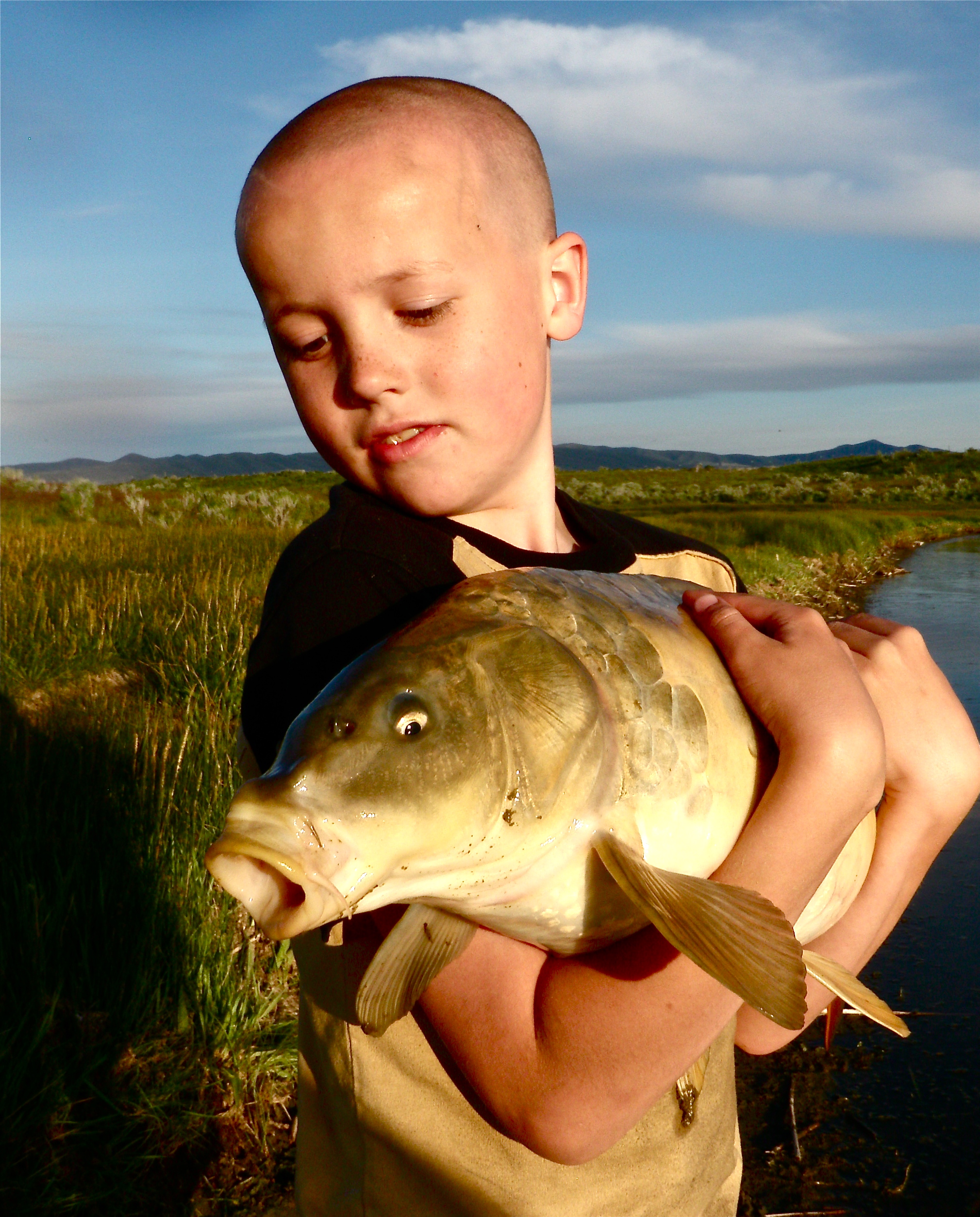Cameron Hunt cradles a big mirror carp from the Minidoka National Wildlife Refuge in Idaho.
By Chris Hunt
My conservation mentor is a hunter who occasionally fishes. I, on the other hand, am a fisher who will tote a gun around looking for birds on occasion. Both of us have had the same conservation epiphany of late.
It’s time to get the lead out. Literally.
I had the chance to spend a weekend with Scott Stouder up at his place in western Idaho earlier this winter. Scott’s as passionate about conservation as anyone I know, and I could talk with him for hours on the need for sportsmen to take the bull by the horns on any number of conservation issues, all while we pass a bottle of good brown liquor between us and share a few laughs. On this last visit, Scott told me that he’s no longer shooting lead when he hunts.
His epiphany came not too long ago when he killed an elk across the Rapid River canyon. A dedicated backcounty hunter, Scott and his hunting partner dressed out the bull and packed it home to the top of the canyon where he lives with his wife, Holly Endersby, a remarkable conservationist in her own right. He left the gut pile behind, and, as luck would have it, he could actually see where he killed the elk from the deck of his house overlooking the canyon—with the help of some high-powered binoculars.
“I saw a bald eagle on the gut pile,” he said. “A bunch of ravens. Magpies. Right then, I knew I was probably causing more damage than I thought I was.”
Lead is toxic to scavengers like eagles and ravens. It has played a significant role in the demise of the California condor that scavenges on hunters’ gut piles in the Southwest. Lead tends to fragment and break apart when it enters the body of a deer or an elk. It ends up in bloodshot meat and, of course, gut piles where the birds get into it. If they ingest it, it can slowly kill them. This isn’t conjecture or some left-wing conspiracy. Lead is bad for birds and scavengers—we’ve known this for a long time, and it’s why lead shot is against the law for waterfowl hunting.
Now, Scott hunts with copper bullets and doesn’t complain one bit about a loss of accuracy or their ability to kill game quickly and humanely. They can cost more—sometimes 50 or even 100 percent more—but the price is worth it, he says, when he considers the impacts lead has on unintended targets.
“There’s no reason for hunters to shoot lead anymore,” he said. “With today’s technology, the alternatives are just as good, just as lethal and just as effective.” Copper bullets are, indeed, just as good as lead.
And there’s no collateral damage.
At the tail end of the Obama administration, then-U.S. Fish and Wildlife Service Director Dan Ashe imposed a ban on lead ammunition and in fishing tackle used on lands administered by the service—national parks and national wildlife refuges, mostly. I fish frequently in the spring and early summer on the Minidoka National Wildlife Refuge in southern Idaho—mostly for carp and smallmouth bass, and my fishing sling usually has some lead in it. I often use split-shot to get a fly down and deep—it helps to get big streamers down to the pre-spawn bass and into the channels of the river where carp are starting to move around in anticipation of warmer weather and warmer water.
But after talking with Scott, I removed the lead from my sling pack. And I did some research. It’s perhaps the easiest tackle item for a fly fisher to replace. There are great alternatives that perform just as well, and they’re not going to break the bank. For years, I’ve been tying flies with tungsten beads instead of using lead-core beads to get flies down. The next logical step for me is to stop using lead altogether, and not just on lands overseen by the USFWS.
I guess that’s me, following Scott’s lead, and taking the bull by the horns. I’m now a lead-free angler. It’s the ethical thing to do—again, lead is toxic to wildlife, fish included. And, as we’ve seen in places like Flint, Mich., it’s bad for people, too. It’s scientifically irrefutable.
This week, new Secretary of the Interior Ryan Zinke signed his first secretarial order. Surrounded by a host of executives from a handful of groups that represent hunters and anglers, Zinke signed an order that overturned Ashe’s directive banning lead from refuges and national parks. Anglers and hunters (not waterfowl hunters, mind you), are free to use toxic lead in their tackle and their ammunition, once again.
If you think about it, a lot of great conservation progress in the sporting world has actually been accomplished by hunters and anglers. We imposed bag limits on birds and game almost a century ago—a move that likely saved the pastime. Half a century ago, the term “catch-and-release” became a part of the fishing vernacular. It, too, has likely saved our craft.
We don’t need a directive or a secretarial order to do the right thing. Let’s fix this fixable problem on our own, like we’ve been doing for decades.
Take the bull by the horns. Get the lead out.
Chris Hunt is the national editorial director for Trout Media. He lives and works in Idaho Falls, Idaho.



